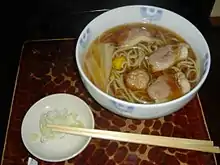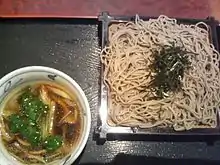Kamo Nanban
Kamo nanban (鴨南蛮) is a Japanese noodle dish made with seasonal soba or udon noodles.[1] in a hot dashi soup of duck (鴨) or chicken meat[2] and leeks[3] or Welsh onions.[4][5][6] On its own, "nanban soba" (南蛮蕎麦) or simply "nanban" might be used, referring to the onions in the dish.[7][5]

When chicken meat is used this is called tori nanban (鳥南蛮) or kashiwa nanban (かしわ南蛮).[5]
Overview

Kamo nanban is one type of "kake soba" (かけそば) and is normally found on the menu of a soba restaurant. It is more expensive when compared to some other soba dishes like tempura soba and tempura seiro soba.
It has been reported that the fatty duck meat used is most delicious in the winter season, and it is also served with seasonal soba which is particularly suited to colder days.
Etymology
The use of duck and scallions is the source of the name.[5] It is said that scallions are referred to after the Nanman, who arrived in Japan during the Edo period and enjoyed eating them to maintain their health.[8][9] The bulb onion used widely in European cuisine, was difficult to come by in Japan until the Meiji period and so scallions were used instead.
There is also a view that it was called nanban due to being a new dish. In the essay Kiyūshōran (嬉遊笑覧) literary and cultural scholar Kitamura Nobuyo (喜多村信節) states of kamo nanban "Things of custom unusual to the past tend to be called 'nanban'".
In the Kinki region, kamo nanban is called kamo nanba (鴨なんば), where "nanba" is a shifted-sound version of "nanban".[10] Also, in Osaka, Welsh onions have been called "nanba" since the Edo period, Nanba (難波) having being a famous producer of Welsh onions, but the actual connection is unknown.[11]
At restaurants which offer both soba and udon, kamo nanban soba (鴨南蛮そば) may be written to differentiate from kamo nanban udon (鴨南蛮うどん), an udon dish with the same flavourings.
History
Bukkake soba (ぶっかけそば), eaten with a hot soup based on soy sauce and flaked bonito, became widespread in the middle of the Edo period. The addition of duck and Welsh onions in the manner of kamo nanban is considered to have been started by the Sasaya (笹屋) restaurant in the Shibakuro-chō area of Nihonbashi.[5] Kamo nanban using about five one-inch pieces of Welsh onion, cut vertically and fried, then boiled with duck, is said to have met the tastes of the time and thrived.[12]
Also in Morisadamankō (守貞謾稿), a work with detail of the Mores of the closing days of the Tokugawa shogunate, Kamo nanban is introduced as "Duck with onions. A speciality of winter."
The consumption of the domestic duck in Japan came about at the end of the Meiji era, before which kamo nanban solely used wild duck.[13]
Ingredients
Domestic duck and wild duck are used. Because natural wild duck is hard to come by, most soba restaurants use cultivated birds.[14] The juicier thigh meat and soft breast meat are used.
In the Taishō period there were instances of rabbit meat being used.[15] In "I am a cat", there is the expression "the ingredient of kamo nanban is like as chicken; the lodge's beef hotpot is like as horse meat" (鴨南蛮の材料が烏である如く、下宿屋の牛鍋が馬肉である如く).[16]
For onions, long Welsh onions which suit duck are used. In some instances, they are only warmed briefly in soup before adding, but frying or roasting in sesame oil is considered to be correct.[17] Cutting into 5cm round slices is common.[18]
For seasoning, chilli pepper or yuzu are used.
Instant Noodles
In 2003, the 'Acecook' Company released the first kamo nanban instant "cup noodle" as one of their large-portion "super cup" instant noodles.
In 2009, Nissin Foods's released duck stock soba version in their "don hyōei" product.
In the 9th episode of the TV drama series "Kurosagi", the kamo nanban cup noodle eaten by the main character was an original version for the show.
Related dishes
Kamo Nuki
Kamo nanban "without duck". Enjoyed as a snack dish with alcohol. The duck meat's fragrance adds a characteristic flavour;[19] alcohol is recommended to match the smell and flavor of broiled duck, umami of the dashi and high grade fat of the duck.[20]
Kamo Seiro

Cold, cooked soba eaten with a dipping sauce of duck meat and Welsh onions. It is said to have been conceived of in 1963 at the Ginza Chōji-an (長寿庵) restaurant[21]
Kamo Nanban Udon
Warm udon with duck and Welsh onions.
Tori Nanban
Similar soba dish using chicken instead of duck. Also called kashiwa udon. "Chicken nanban" is an entirely different non-noodle dish with chicken cutlet and onions.
References
- Barakan, M.; Greer, J. (2012). Tokyo New City Guide. Tuttle Publishing. p. 84. ISBN 978-1-4629-0423-5.
- Ventiera, Sara (March 30, 2015). "Explore Japanese Street Food at Boerum Hill's Ganso Yaki". Village Voice. Retrieved April 7, 2016.
- De Mente, B.L. (2011). Dining Guide to Japan: Find the right restaurant, order the right dish, and pay the right price!. Perseus Books Group. p. pt92. ISBN 978-1-4629-0317-7.
- Itoh, Makiko (May 15, 2015). "Nanban dishes are fit for a barbarian". The Japan Times. Retrieved April 7, 2016.
- 岩田義人(信州生まれ、食品会社勤務後、蕎麦屋を経営)【鴨南ばん】「季節蕎麦。代表的な種物の一つ。鴨なんばんは馬喰町橋づめの笹屋など始めなり」と、『嬉遊笑覧』に記されている。『江戸見草』で、「鴨南ばん」の値段は最も高い。」
- 英語では、duck and green onion("東京都『外国人旅行者向け応対・表記事例集 飲食施設』" (PDF).)、soba noodles served with a cooked duck on top(ボブと花子の「Eat and Speak Soba」 - 日本麺類業団体連合会 Archived 2012-06-10 at the Wayback Machine)などと説明的に表現される。
- 蕎麦屋の店主が教える蕎麦のあれこれ「蕎麦の南蛮とは?」
- "そば屋メニュー紹介 鴨南蛮そば - 日本麺類業団体連合会". Archived from the original on 2012-06-10. Retrieved 2014-10-19.
- 梅棹忠夫他(監修)『THE日本 日本が見える、日本が読める大事典 Visual human life』講談社, 1986年, p.453
- 小松寿雄・鈴木英夫(編)『新明解 語源辞典』三省堂, 2011年, p.254
- "麺類雑学事典「鴨南蛮」 - 日本麺類業団体連合会". Archived from the original on 2007-12-15. Retrieved 2014-10-19.
- 田村栄太郎『江戸時代町人の生活』雄山閣, 1966年, p.137
- 奧山益朗(編)『味覚辞典 第1巻』東京堂出版, 1972年, p.39
- 古川修『蕎麦屋酒 ああ、「江戸前」の幸せ』光文社, 2004年, p.22
- 高井寿雄『蜂が飛ぶ』文芸社, 2000年, p.58
- 夏目漱石『漱石全集第一巻 吾輩は猫である』漱石全集刊行會, 1918年, p.303
- 新島繁『蕎麦入門』保育社, 1992年, p.115
- 東海林さだお『おにぎりの丸かじり』文藝春秋, 2010年, p.63
- 松石昌典・加藤綾子・石毛教子・堀剛久・石田雄祐・金子紗千・竹之中優典・宮村陽子・岩田琢磨・沖谷明紘「名古屋コーチン,ブロイラーおよび合鴨肉の食味特性の比較」『日本畜産学会報』76巻, 2005年, p.429
- �古川修『蕎麦屋酒 ああ、「江戸前」の幸せ』光文社, 2004年, p.29
- The obsession of Chōji-an - Ginza Chōji-an